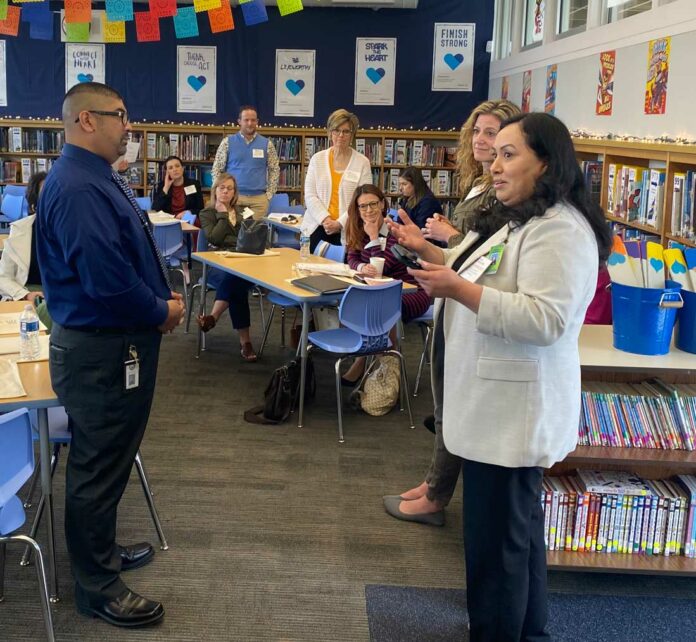
R.O. Hardin Elementary School in early May hosted school leaders from throughout the nation who came to witness an innovative early literacy program and learn how to replicate its success.
The Hollister School District site May 4 hosted educational leaders who included state superintendents, governors and other top policymakers. It was the latest in a series of visits to R.O. Hardin involving education leaders from other areas who have interest in this approach to literacy instruction.
Dozens of education leaders visited the school where literacy measurables have improved drastically over the past four years. That is when R.O. Hardin administrators embarked on a groundbreaking literacy partnership with Seaside-based Chartwell School and the University of California San Francisco’s Dyslexia Center that has led to remarkable advancements.
The visit was in collaboration with the Hunt Institute, which aims to “bring together people and resources to inspire and inform elected officials and policymakers about key issues in education.”
R.O. Hardin is among four Hollister School District campuses using the model, while the approach will be brought to all of the district’s schools starting next year, said Dr. Colleen Myers, director of educational services.
The literacy program focuses on small-group instruction using the Chartwell model, the Preventing Academic Failure reading program and ongoing neuroscience analysis from the UCSF Dyslexia Center. R.O. Hardin intervention teacher Nikki Bell oversees a team of instructional aides who play a key role in allowing for the small-group, one-on-one approach.
Led by educators and administrators from the Hollister School District, the visitors met the morning of May 4 in the school library before heading off in groups to monitor the classrooms where the approach has been implemented.
They saw the results firsthand. In a kindergarten class, an instructional aide sounded out “G-A-S” while prompting three students at the table to spell along and then pronounce the word.
“Wait, I get to do another one,” insisted an eager young student.
At a table of four, another instructor was going through the alphabet and asking students what sound to make for each letter. These are among many examples of what the hands-on approach looks like.
These were just a couple examples representing the atmosphere at R.O. Hardin.
Bob Wise, a Chartwell board member and the former governor of West Virginia, was once again in awe of the implementation at R.O. Hardin.
“This is another indication of how much progress Hollister is making,” Wise said outside one the classrooms while educators moved from room to room. “These folks are literally leaders from across the country in different states. You’ve got two state superintendents here as well as representatives of the California Superintendent’s Office. This is going to guide policy decisions and teaching decisions across the country.”
Those May 4 visitors had spent the prior day at UCSF along with State Superintendent Tony Thurmond learning about the neuroscience end of the equation. After the tour of classrooms, educators returned to the library for a panel discussion with a Q&A opportunity that involved Myers, Bell, R.O. Hardin Principal Lilia Espinoza, R.O. Hardin teacher Christine Branon and Napa County Superintendent Barbara Nemko who moderated the talk.
Espinoza was asked to kick off the discussion and recalled a moment with teachers when she arrived as principal four years ago.
“In the conversation with teachers, we just said, ‘We have to do something different.’ They all agreed,” she said. “We have to do something different, and it’s going to take every one of us.”
Nemko asked Espinoza to share some data that show progress since the program began upon her arrival.
She noted at the start of the school year, 68% of kindergartners couldn’t read with 26% knowing some letter names and sounds. Now, there are just three students—who are all relative newcomers—still not reading or knowing letter sounds. She said 58% of kindergartners are at grade level with 38% above grade level now.
For kindergarteners through first graders, 22% were at grade level and 2% were above grade level to start the year. Now, 33% are at grade level with 16% above. She said 55% of all students have shown growth.
“That, to me, is huge,” she said.
When Espinoza mentioned this is the first time ever for the school having students reading above grade level, the visiting educators gave an enthusiastic applause.
Myers also stressed to the group how at-risk and accelerated students all take part.
“No longer are we sectioning off students to another classroom,” she said.
Hollister School District Superintendent Erika Sanchez joined the tour and panel discussion while welcoming all of the distinguished officials. While moving from classroom to classroom, Sanchez spoke to one of the groups about the challenges districts face, particularly when there are budget cuts, and how it’s necessary to continually adapt.
“It’s the story of what truly happens,” she said. “You have to pivot. You have to be resilient.”









